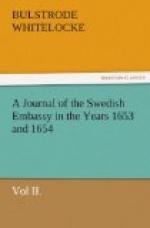The Chancellor said it was the custom to deliver the original letters of power into the hands of the other party, that they might be registered in the public acts of the Chancery, and that Whitelocke should receive their commissions to carry with him into England; that if he would pass his word that, at his return to England, he would procure new and larger powers, and take care to send the letters of them hither from the Protector, they should be satisfied therewith: which Whitelocke promised to do, and desired that the Queen would ratify all that should be done here before her resignation, and keep the ratification by her until the Protector should seal letters of ratification on his part, and then they might be exchanged and mutually delivered. The Chancellor consented hereunto, and asked what seal the Protector used in these public businesses. Whitelocke said he used his own seal. The Chancellor asked if he did not use the seal of the Commonwealth, in regard that this league was between the Queen and kingdom of Sweden and the Protector and Commonwealth of England. Whitelocke said that the Protector might, if he pleased, command the seal of the Commonwealth to be affixed to the letters of ratification, which he believed would be done if they desired it; and that, by the same reason, it was fit that the letters of ratification here should be under the Great Seal of Sweden.
The Chancellor said that in Sweden, when the Government was in the hands of Commissioners, the King or Queen not being crowned, it was usual for some chief men, of alliance to the deceased King, to make use of his private seal, and of no other; that if this treaty were with the Poles or Danes, or others, that being wanting in their letters which was in Whitelocke’s, he would not proceed any further with them until they should procure a fuller power and commission; and he said he had been present at many treaties which had been broken off upon a less defect than appeared in Whitelocke’s letters. But in regard their business was with the Protector, whom the Queen and himself did so much honour and had so great a confidence in him, and upon Whitelocke’s promise to procure such a power as they desired to be enlarged to him from the Protector, the Chancellor said they were ready to confirm the articles with their seals. Whitelocke took upon him what they desired, and then the Chancellor and his son Eric sealed that part of the articles which Whitelocke had prepared, and Whitelocke sealed the other part of the articles which had been prepared by the Chancellor and his son Grave Eric.[168]




